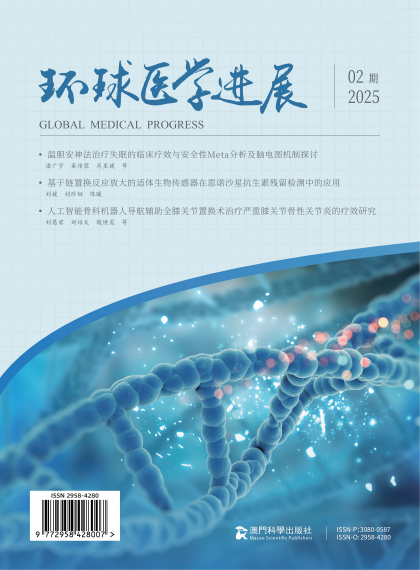摘 要:
目的:探讨人工智能骨科机器人导航辅助全膝关节置换术在治疗严重膝关节骨性关节炎的临床疗效。方法:回顾性分析2022年12月至2024年4月在蚌埠市第一人民医院因膝关节骨性关节炎接受全膝关节置换的患者36例,根据术中是否采用和华瑞博HURWA骨科机器人导航系统分为试验组(AI导航辅助TKA)与对照组(传统TKA),每组各18例患者入组。测评试验组的AI技术性能结果包括分割精度、分割速度、平台兼容性及数据通用性。同时比较两组患者术后下肢力线误差、膝关节活动度、美国膝关节协会评分(Keen Society Score,KSS)、西大略和麦克马斯特大学骨关节炎指数评分(Western Ontario and McMaster Universities Osteoarthritis Index,WOMAC),以及手术相关并发症的发生率。结果:36例患者均 获得随访,随访时间(12±2.1)个月。试验组的AI技术性能结果包括分割精度、分割速度、平台兼容性及数据通用性均满足临床需求。术后1年下肢力线误差方面,试验组力线误差为(0.7°±0.3°),显著低于对照组的(2.8°±0.9°),差异具有统计学意义(P<0.001)。膝关节功能方面,术后1年试验组膝关节活动度为(118.5°±8.2°),显著高于对照组的(102.3°±10.5°);试验组KSS评分为(91.2±5.3)分,显著高于对照组的(84.9±3.2);试验组WOMAC评分为(12.6±4.1)分,显著低于对照组的(14.7±4.8),差异具有统计学意义(P<0.001)。术后试验组出现1例膝关节浅表感染,经单纯清创后治愈;对照组出现1例膝关节置换术后关节僵硬,经麻醉下闭合手法松解后好转;对照组出现1例膝关节置换术后疼痛,经局部神经阻止后好转。结论:全膝关节置换术是治疗终末期膝关节骨性关节炎的有效方法,人工智能骨科机器人导航系统在技术性能上表现优异,且能显著提高 全膝关节置换手术的疗效和精度,值得临床推广。
关键词:人工智能;骨科机器人;全膝关节置换术;导航辅助量
Abstract:
Objective: To explore the clinical efficacy of AI orthopedics robot navigation-assisted total knee arthroplasty in treating severe knee osteoarthritis. Methods: A retrospective analysis was performed on 36 patients who underwent knee arthroplasty at Bengbu First People’s Hospital between December 2022 and April 2024. Based on whether the HURWA orthopedic robot navigation system was used during the surgery, patients were divided into the experimental group (AI-assisted TKA) and the control group (traditional TKA), each group included 18 patients. The AI technology performance results of the evaluation test group include segmentation accuracy, segmentation speed, platform compatibility, and data universality. At the same time, the postoperative lower limb force line error, knee joint mobility, American Knee Society Score (KSS), Western Ontario and McMaster Universities Osteoarthritis Index (WOMAC), and the incidence of surgery-related complications were compared between the two groups of patients. Results: All 36 patients were followed up for an average duration of (12±2.1) months. The AI technology in the experimental group demonstrated performance results that met clinical needs, encompassing segmentation accuracy, segmentation speed, platform compatibility, and data interoperability. One year post-surgery, the lower limb alignment error in the experimental group was (0.7°±0.3°), significantly lower than that of the control group (2.8°±0.9°), with a statistically significant difference (P<0.001). In terms of knee joint function one year post-surgery, the experimental group exhibited a range of motion of (118.5°±8.2°), significantly higher than that of the control group (102.3°±10.5°). Additionally, the KSS in the experimental group was (91.2±5.3), notably higher than that of the control group (84.9±3.2), while the WOMAC score in the experimental group was (12.6±4.1), significantly lower than that of the control group (14.7±4.8), with all differences being statistically significant (P<0.001). In the experimental group, one case of superficial knee joint infection occurred post-surgery and was successfully treated with simple debridement. In the control group, one patient experienced joint stiffness following knee replacement surgery, which improved after closed manual manipulation under anesthesia, and another patient reported pain post-surgery, which was alleviated with a local nerve block. Conclusion: TKA is an effective method for treating end-stage knee osteoarthritis. The artificial intelligence-based orthopedic robotic navigation system excels in technical performance and can significantly enhance the efficacy and precision of total knee arthroplasty, making it worthy of clinical promotion.
Keywords: Artificial intelligence (AI); Orthopedics robot; Total knee arthroplasty (TKA); Navigation-assisted
--
